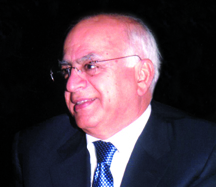Iran, Al-Rubaie and history
i ran has played a destabilizing role in the arab region, which resulted in its almost complete control over the decisions of four arab capitals, and its mullahs did not hesitate to praise this from the podium.
on the other hand, some believe that the dispute with it turned, over time, into unjustified hostility, took a sharp sectarian turn, and increased the hostility of the two parties to each other and their ignorance of each other.
this is attested to by the fact that the curricula of the schools of both parties and their media are devoid of almost anything about the other. if we compare the percentage of arabs who visit iran annually, for reasons other than religious matters, we would find them in the thousands, compared, for example, to the tens of millions who visit turkey, and the reasons for this are many!
in a serious study carried out by the iraqi researcher fadel al-rubaie, and our colleague abdul-ghani salama had previously touched upon it almost 10 years ago, as almost nothing has changed since that day, al-rubaie presented in his study an image that even those sympathetic to iran may not know, contrary to what the arab media has tended to portray, introducing it, especially recently.
al-rubaie first asks about the secret of the hysterical verbal hostility towards iran, stressing that criticizing iranian politics is a legitimate right, but it has turned over time to defaming iranian history, values, and culture, demonizing them and using racist descriptions such as magians, safavids, shiites, jews and temporary marriage ... etc.
“it is often met with the same obscene words from the other side, pointing out that the criticism directed is not subject to any ethical or scientific standard, as both sides do not have research centers specialized in iranian or arab studies, and all those who attack iran are ignorant of its history and geographical and demographic composition but are merely heresy and wrong judgments, and even if we consider iran an enemy, it is sad to fight “enemies” about whom we know nothing.
“there is no country in the world that has formed its identity independent of the influence of its neighbors, even if they were invaders. in this context, iraq contributed, to a vital degree, to the formation of iranian identity, and not the other way around, as the iranian identity was formed linguistically, under the influence of its iraqi neighbor, since the ancient persian language replaced its “indo-european” alphabet with the “iraqi cuneiform” alphabet, and then adopted its current language in its letters and the rules of writing it in arabic, abandoning its ancient language, and also part of its history, to attribute its roots to islamic history, and dealt with it as a part of it.
iran has also been influenced by iraqi worship since ancient times. ishtar was a common deity for the two peoples. just as the ancient iraqis mourned the death of the god tammuz, the ancient iranians led processions of tears and weeping for him. today, the two peoples cry over their religious symbols. in this context, al-rubaie believed that ancient iran was a great civilization, but without a great religion, and this deficiency formed in it a complex that prompted it to search for a religious message, so they learned the qur’an in the arabic language, abandoning their ancient religions.
al-rubaie confirmed that describing the iranians as magi includes a major fallacy, as the word is a derogatory description given by the persian pagans to the monotheists who preach one god (zoroastrianism around 1500 bc), which means that the persians are something different from the magi. still, safavidism is something else, as it is not a religion.
it is not a religious sect, nor does it indicate contemporary shiites, but rather a political sufi movement that used the heritage of islam to confront the ottomans, and belongs ethnically to the seljuk turkmen, who waged a struggle against the ottomans against the backdrop of an ethnic conflict, and after their takeover of iran they approved the twelver shiite sect as an official doctrine of the state, and it has ended—safavidism with iran’s conversion to shiism. also, saying that iran was the one that imposed shiism on the iraqis is a falsification of history, as the opposite is true.
persians make up 49% of the population, turks and azeris make up about 20%, and arabs make up about 7%, as do kurds. iran’s senior religious leaders are not persians, and the majority of them are fluent in arabic.
regarding the nature of the danger posed by iran, al-rubaie believes that it has never had expansionist ambitions, even though it fought with its turkish and iraqi neighbors for long periods, as it was a traditional struggle over interests and areas of influence, in which the two sects (sunni and shiite) played the role of ideological cover to cover it up on his self-interested nature.
one of the common mistakes is linking shiites with persian nationalism. iran knew the shiite doctrine approximately 500 years ago, but persianism is a national component that preceded shiism for thousands of years. they are originally two conflicting components within the iranian identity itself, and this is what is difficult to notice, this conflict intensified in the interest of persian nationalism, in the days of pahlavi in 1925, then returned to the interests of shiism with the khomeini revolution in 1979.






